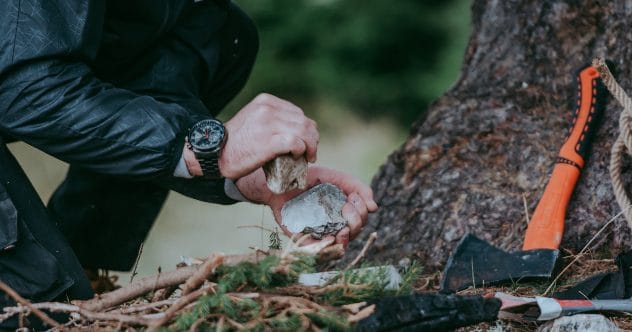Life is unpredictable. One minute everything’s normal, and the next, you could face an unexpected challenge. Whether it’s getting lost on a hike, a sudden storm, or a larger disruption, being ready makes all the difference. Your ability to handle a survival situation often hinges on preparation.
Every emergency is unique. Sometimes challenges are short-lived, like losing power for a day. Other times, they might last longer. Where you are – city or countryside – also changes things. Thinking ahead about what you’d do and how to keep your family safe is crucial.
You don’t need to spend a fortune on fancy gear to get started. Creating a basic ‘go-bag’ or a 72-hour kit can significantly improve your odds. Surprisingly, many essential survival items might already be scattered around your home. Let’s explore ten everyday things that prove invaluable when things get tough.
Swiss Army Knife
It’s hard to beat the classic Swiss Army knife for versatility. These tools have been trusted companions for over a century, constantly improving. Many models boast helpful attachments like can openers, screwdrivers, and tweezers – things you don’t realize you need until you really need them.
While not the cheapest gadget, a genuine Swiss Army knife offers excellent quality and reliability. Consider having more than one, perhaps keeping a spare in your car or emergency kit. Its uses are vast: starting fires, preparing food, making small repairs, or even basic first aid. It’s more than just a pocketknife; it’s a compact problem-solver. Pairing it with a small hatchet could round out your tool needs nicely.
First Aid Kit
A well-stocked first aid kit is non-negotiable. Even minor injuries can become serious without proper care. Ensure your kit contains essentials like sterile wipes for cleaning hands and wounds, antiseptic solutions (like iodine or alcohol), various bandages, gauze, medical tape, and pain relievers like aspirin.
Don’t forget extras like tweezers, small scissors, and maybe even some insect repellent. Regularly check your kit’s contents. If you use something, replace it immediately. Ensure expiration dates haven’t passed, especially for medications and wipes. Keep it somewhere easily accessible so you can grab it quickly in an emergency.
Waterproof Matches or Lighter
Fire is fundamental for survival. It provides warmth, light, a way to cook food, boil water, and signal for help. Gather any spare lighters you have. Better yet, invest in waterproof matches or learn how to make your own – it’s surprisingly easy! These work even when damp, unlike regular matches.
Camping stores and online retailers offer various fire-starting options, including long-lasting lighters and flint-and-steel kits. While flint and steel are reliable, they require practice. Here’s a fun tip: crayons! Made of wax, a single crayon can burn for up to 30 minutes, acting like a mini candle or fire starter. Toss a few in your kit.
Food and Water (or Purification)
While serious preppers store food for long periods, everyone should have at least a 72-hour supply of non-perishable food and a plan for water. Think high-energy, easy-to-prepare items like granola bars, trail mix, dried fruit, jerky, canned goods (if you have that Swiss Army knife!), and maybe some instant oatmeal or coffee.
Water is critical, but carrying large amounts is impractical. Focus on purification methods. Include water purification tablets (chemical sterilizers), a portable water filter pump, or at least a small metal pot for boiling. Boiling is effective but requires fire. If sourcing water from nature, try to find running water upstream and inspect the area for contamination. Boil vigorously for at least one minute (longer at high altitudes). If stuck at home during an emergency, fill bathtubs and sinks with tap water as a reserve, but still plan to purify it before drinking.
Sturdy Footwear
Protecting your feet is paramount, especially if you need to travel on foot. Good quality boots offer support and protection. Ensure they fit well – not too tight, which causes blisters. Break in new boots by wearing them around the house or on short walks before packing them away.
If sturdy boots aren’t an option, find the best pair of closed-toe shoes you own. Sneakers are far better than sandals or dress shoes. Check your closet for those old running shoes you haven’t worn in ages. They might just become your most valuable footwear in a pinch. Good shoes mean you can move faster and safer.
Sleeping Bag
A sleeping bag provides warmth and shelter, crucial for rest and recovery. Aim for one that is lightweight, reasonably compact, and offers some water resistance. You don’t need the most expensive expedition bag, but choose one appropriate for your climate. Modern materials offer good warmth without excessive bulk.
Many sleeping bags can be strapped to the outside of a backpack to save internal space. Consider adding a lightweight sleeping pad for insulation from the cold ground. If you don’t have a pad, improvise by gathering dry leaves or grass. If you have kids, check their sleeping bag size every six months or so to ensure they haven’t outgrown it. Having your sleeping bag packed and ready means one less thing to worry about if you need to leave quickly.
Stove (Portable)
A portable stove allows you to cook food and boil water efficiently. While gas canister stoves are popular, fuel can run out and canisters are heavy. Wood-burning stoves are an excellent alternative for longer situations, using readily available twigs and small pieces of wood as fuel.
Gather dry wood whenever you have the chance, especially early in the day, and let it dry further if needed. Set up your stove on a flat, stable surface away from flammable materials. Learning to use a portable stove safely is a valuable skill for any outdoor or emergency situation.
Analog Watch, Compass, and Maps
Never rely solely on your smartphone for navigation. Batteries die, signals drop, and phones break. A traditional magnetic compass and physical maps of your local area are essential backups. Learn basic map reading and compass skills – there are many great tutorials online.
Why an analog watch? Besides telling time, you can use it to find direction (there are techniques involving the sun and the hour hand). Detailed topographical maps (like USGS maps in the US or Ordnance Survey in the UK) show terrain, water sources, roads, and trails, helping you understand your surroundings and plan routes. These tools don’t need batteries and could be lifesavers.
Waterproofs
Staying dry is crucial for comfort and preventing hypothermia. Pack lightweight, waterproof outer layers like a rain jacket and pants. Even inexpensive rain gear is better than nothing. Keeping your core clothing dry is vital.
Pay special attention to your feet – carry extra pairs of socks and change them immediately if they get wet to avoid blisters and foot problems. Use downtime or sunny periods to dry out damp clothing near a fire (carefully!) or laid out in the sun. Dig through your closet for spare water-resistant jackets, hats, or gloves you can add to your kit. Function over fashion is the rule here!
Rucksack or Backpack
You need something reliable to carry all your gear. Choose a rucksack or backpack that’s comfortable, durable, and preferably water-resistant. You don’t need the most expensive tactical bag; a sturdy backpack from a reputable brand will often suffice. Ensure the straps are comfortable and distribute weight evenly.
The key is having something you can wear comfortably for extended periods, keeping your hands free. Avoid tote bags or suitcases. Pack your essentials beforehand, keeping the bag ready to go. Knowing your survival kit is packed and waiting provides peace of mind.
So there you have it – ten everyday items that transform into vital survival tools. Being prepared doesn’t have to be overwhelming or expensive. Start by gathering these basics, and you’ll be much better equipped to handle whatever life throws your way.
Stay safe and be prepared!
What other everyday items do you think are essential for survival? Leave your comment below!










